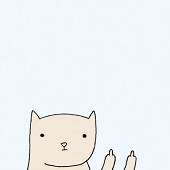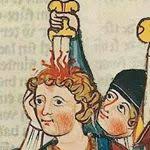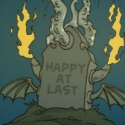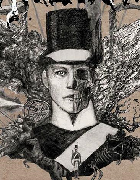|
At least here in the PNW, all kendo tournaments are straight knockout. No pools. This can royally suck if you travel from far. A couple of years back, I beat a guy from Mexico in the first round and he clearly wasn't impressed :/ Larger tournaments will have about up to 400 participants, spread into 6-8 individual categories & 2 team categories (senior/junior). All of them are 1 day events and take place on 3-5 courts. Refereeing can be brutal, depending on the amount of referees. 3 referees on court and you rotate 1 out every 2 matches, meaning that you are on court for about 25-40 minutes, with sometime as little as a 20 min break.
|
|
|
|

|
| # ? May 10, 2024 09:01 |
|
Considering this stuff is pretty alien to me, how difficult is it to do a decent cut? What's the balance between force, technique, weapon quality, and does the mat itself (like, tightness of roll) affect things much? And do you think it's realistic much from a "I want to actually kill this guy" martial arts point of view? I wonder if this is an attempt to heading things off at the pass, or whether there was a specific incident that triggered the whole thing.
|
|
|
|
BirdOfPlay posted:Over 4,000 fencers will be at the US Fencing Summer Nationals and July Challenge in Salt Lake City, which is a 10 day event. The bigger events in fencing here just get ridiculous at times. For us in the Olympic side, we've got a lot of officials (refs, armorers, and bout committee) that do an incredible job keeping these things running smoothly. 111 competitors and the following events: Longsword (Adult, Women's Teen, Youth), Rapier&Dagger(Adult, Teen, Youth), Sword&Buckler(Adult, Teen, Youth), Cutting, Ringen, Forms (Adult, Teen, Youth).
|
|
|
|
Crazy Achmed posted:Considering this stuff is pretty alien to me, how difficult is it to do a decent cut? What's the balance between force, technique, weapon quality, and does the mat itself (like, tightness of roll) affect things much? And do you think it's realistic much from a "I want to actually kill this guy" martial arts point of view? https://www.youtube.com/watch?v=2SM90S6TrD8 I cut again a week later with a much "better" sword (better in that it is said to quickly point out technique flaws, ~$900, but also has a super short handle for a big guy like me) and managed 2/3 cuts that I attempted. https://www.youtube.com/watch?v=xMeoa0TRarw From my point of view, it was helpful to see how bad my technique was on one of the basic cuts. I wasn't under pressure, or wearing protective gear, so if I can't do it without those constraints, I certainly can't do it correctly with those constraints. My understanding is that this is the Longpoint League's (covers north eastern US) initial vision when they formed in 2010, and they are finally able to implement it.
|
|
|
|
Crazy Achmed posted:Considering this stuff is pretty alien to me, how difficult is it to do a decent cut? What's the balance between force, technique, weapon quality, and does the mat itself (like, tightness of roll) affect things much? And do you think it's realistic much from a "I want to actually kill this guy" martial arts point of view? It's relatively simple to do a cut, it's a bit more complicated to do a good cut. The main physical components you want to focus on are sending out the tip of your sword first (i.e. not letting your sword tip drag behind your hands), connecting the tip of your sword to your hip (i.e. the motion of your hip is directly influencing the motion of the blade), and a good extension of the arms. After those three there are a ton of tiny tweaks to consider when necessary. Things like relaxing the shoulders, squeezing the grip at the right moment, making sure the blade is staying on a single straight plane, etc. There are some people who will just get it. There's a dude in our class who is actually turning out to be an excellent cutter because he gets that 1:1 sword motion down perfect every time he swings. It helps that his sword is very sharp and very long, as the portion of the blade that cuts will be moving faster relative to a shorter sword's cutting portion, but even considering those conditions, his form is solid and the cuts he performs are at near perfect angles and are very consistent. There are some people who just don't get it, and from what I've seen the physiological differences in those people are fairly apparent (though, admittedly, some people just don't get it by virtue of not getting it). I'm currently speaking with a group of women fencers who are sharing their experiences with cutting and the physical difficulties they have with it. Chest size plays a big role in hand placement, since some motions can't be completed by the simple fact that there's a breast in the way. Shoulder width is another issue, and many of the women I know who can cut very well tend to have very broad shoulders. We have ideas on how to mitigate these issues, usually by increasing the length of the sword or changing the starting hand position in some cases. But it's evolving as we move forward. As for the ruling itself: It's meant to head things off at the pass. As far as I know there hasn't been one triggering incident that has sparked this. From what I've gathered people were happy with the increasing performance of fencers entering Longpoint specifically, and the triathalon was a success in how it challenged and uplifted fencers who did well in multiple categories (triathalon was basically whoever had the most points accumulated over several different events including longsword, rapier, wrestling, cutting, and paired technique). I understand their reasoning for why they want some kind of qualifier for LP, but they chose one of the worse options imo, and my biggest concern personally is the reaction they have had in defending it from otherwise reasonable people and arguments. Verisimilidude fucked around with this message at 16:13 on Jun 30, 2017 |
|
|
|
I use a one-handed sword, which isn't quite the same, but we try to move the left arm at the same time as the right. This helps guide the shoulders, which adds power to cuts and blocks. Also, when comparing people cutting at your group, are they all using handles of roughly equal length? There's a huge difference to be made there and even different arm lengths will affect that. I think this is a case where simply being taller, with all other things being equal will make cutting easier.
|
|
|
|
Hazzard posted:I use a one-handed sword, which isn't quite the same, but we try to move the left arm at the same time as the right. This helps guide the shoulders, which adds power to cuts and blocks. Grip length typically varies from sword to sword, and spacing between grips is a topic of discussion. JSA tend to have some space between grips, while HEMA cutters err on the side of hands being together. Height is a big contributor, and we are also looking at things like shoulder width, hip torsion, chest compression.
|
|
|
|
A guy who does Sabre, Rapier and Sidesword is back at my club for a while. It's made me realise how short our blackfencer broadswords are. Blackfencers are lovely weapons and I'll recommend them to everyone, but the Broadsword is really short and I don't know why.
|
|
|
|
The basket hilts with straight 32" (82 cm) blades? That's what the pattern length was for a British military broadsword in the 19th century.
Siivola fucked around with this message at 11:08 on Jul 7, 2017 |
|
|
|
The Rawlings we use are slightly longer. According to the HEMA Shop, they have a blade length of 87cm. That comes up to my hip bone, or just as far as my arm with my thumb up. Both of which amount to about the same and are recommendations from two different manuals. I compared 82 cm to my leg length. I'd say I have at least a fist's width on it. Everybody in the club agrees they are too short. At 6 ft the Rawlings is perfectly sized for me. In short, most regulation British Military Swords were not good. The broadsword is too short for example.
|
|
|
|
Hazzard posted:In short, most regulation British Military Swords were not good.
|
|
|
|
That reminds me. Is anyone else going to Fight Camp? It's Matt Easton's scaled up version of Fight Club, with less philosophy and more history. I'll see if I can get an answer about why regulation military swords aren't so good.
|
|
|
|
Hazzard posted:That reminds me. Is anyone else going to Fight Camp? It's Matt Easton's scaled up version of Fight Club, with less philosophy and more history. I'll see if I can get an answer about why regulation military swords aren't so good. If military procurement and regulation-writing was anything then like it is now, it's because the people in charge of those things are too divorced from the end user to make decisions based on meaningful aspects rather than budgetary concerns and superficial appearances.
|
|
|
|
The weird thing is, they clearly had experts designing some swords. The 1796 Light and Heavy Cavalry Sabres were both designed by the same person. John Le Marchant also wrote a cavalry fencing manual adopted by the cavalry. The 1796 Light Cavalry Sabre is considered one of the better sabres out there, while I've heard nothing but bad things about the heavy sword. Despite being designed by the same man. Although I've been told that the heavy sword only existed because the Dragoon Guards refused to use a curved sword, which may mean the blade design was rushed.
|
|
|
|
I remember hearing the heavy is a direct copy of some continental pallasch or another, but with a worse (not-stabby) point.
|
|
|
|
Someone in my club says that the soldiers seem to have chosen what kind of point they wanted. Some swords have hatchet points, some have spear points. So which you came across in a fight is random. I don't remember him saying if there's any trend towards one or the other.
|
|
|
|
In a similar vein, I've read that, at least in the US, sabers were issued blunt and it was left to the user to decide to sharpen it or not. Figure that when you're going 20 mph on a horse, it doesn't really matter how sharp your weapon is.
|
|
|
|
dupersaurus posted:In a similar vein, I've read that, at least in the US, sabers were issued blunt and it was left to the user to decide to sharpen it or not. Figure that when you're going 20 mph on a horse, it doesn't really matter how sharp your weapon is. No, it absolutely does matter whether your saber is sharp. Swords were issued blunt because the blade would be dulled by banging around inside the (typically metal) scabbard. There was no point in issuing sharp weapons so that the blade would just be blunted while riding around in for garrison/parade duty. Swords would be sharpened when a unit was actually deployed for combat and then resharpened between engagements to keep them ready for fight. Sometimes British soldiers would use "field scabbards"made out of wood and leather to get around the blunting effect of metal scabbards. This was especially the case for soldiers in India, where hand-to-hand combat was much more prevalent than in typical European conflicts. Grenrow fucked around with this message at 22:33 on Jul 9, 2017 |
|
|
|
Grenrow posted:No, it absolutely does matter whether your saber is sharp. Swords were issued blunt because the blade would be dulled by banging around inside the (typically metal) scabbard. There was no point in issuing sharp weapons so that the blade would just be blunted while riding around in for garrison/parade duty. Swords would be sharpened when a unit was actually deployed for combat and then resharpened between engagements to keep them ready for fight. Sometimes British soldiers would use "field scbbards"made out of wood and leather to get around the blunting effect of metal scabbards. This was especially the case for soldiers in India, where hand-to-hand combat was much more prevalent than in typical European conflicts. Reasons I'm an olympic fencer
|
|
|
|
Fun fact, the "scwing" noise swords make when coming out of scabbards in films is kindof accurate. If you have a steel rim on the top, then you get a noise. Unfortunately, it also blunts the blade. You get the noise or you get a sharp sword, but not both. Although people did get into a fight with a blunt sword, but this wouldn't have been deliberate. I think there's examples in the Indian Mutiny of Cavalry getting ambushed between arriving in India and having a chance to sharpen your sword.
|
|
|
|
Grenrow posted:No, it absolutely does matter whether your saber is sharp. Swords were issued blunt because the blade would be dulled by banging around inside the (typically metal) scabbard. There was no point in issuing sharp weapons so that the blade would just be blunted while riding around in for garrison/parade duty. Swords would be sharpened when a unit was actually deployed for combat and then resharpened between engagements to keep them ready for fight. Sometimes British soldiers would use "field scabbards"made out of wood and leather to get around the blunting effect of metal scabbards. This was especially the case for soldiers in India, where hand-to-hand combat was much more prevalent than in typical European conflicts. To be fair, apparently it actually was fairly common practice of cavalrymen in the US Civil War to leave their sabres unsharpened. However, that was not so much due to any practical consideration, but rather because at that point in time the sabre had been largely superseded by carbines and handguns as the primary weapon of choice for cavalry. And when you're dealing with soldiers, the rule #0 is that they'll be looking for any way to avoid whatever work doesn't seem necessary to their immediate survival. While a sharpened sabre would undoubtedly be way more effective, I guess even a blunt one could still be reasonably dangerous in a pinch when swung from horseback. So you'd end up with a whole lot of blunt sabres mostly because their owners figured "why bother?". It became such a common practice that there's actually a weird (but possibly apocryphal) anecdote about an instance where people went against it. A Union cavalry colonel by the name of Minty ordered his brigade to properly sharpen all their sabres because, well, duh. But when the Confederates learned about it, they threw a complete shitfit. They decried the use of sharpened blades as barbaric and against proper modern gentlemanly warfare, and threatened to immediately execute any prisoner found in possession of a sharp sabre.
|
|
|
|
I'm aware of the practise of Union Cavalry using repeating rifles, which caused the Confederates to start carrying several revolvers, because they lacked the number of repeating rifles to counter the Union. I'm guessing many stopped carrying sabres just because it would save on weight and make it easier to carry extra ammunition and revolvers.
|
|
|
|
Perestroika posted:To be fair, apparently it actually was fairly common practice of cavalrymen in the US Civil War to leave their sabres unsharpened. However, that was not so much due to any practical consideration, but rather because at that point in time the sabre had been largely superseded by carbines and handguns as the primary weapon of choice for cavalry. And when you're dealing with soldiers, the rule #0 is that they'll be looking for any way to avoid whatever work doesn't seem necessary to their immediate survival. While a sharpened sabre would undoubtedly be way more effective, I guess even a blunt one could still be reasonably dangerous in a pinch when swung from horseback. So you'd end up with a whole lot of blunt sabres mostly because their owners figured "why bother?". *hacks at enemy with blunt sword* We are truly the gentleman's army.
|
|
|
|
Perestroika posted:While a sharpened sabre would undoubtedly be way more effective, I guess even a blunt one could still be reasonably dangerous in a pinch when swung from horseback. Perestroika posted:It became such a common practice that there's actually a weird (but possibly apocryphal) anecdote about an instance where people went against it. A Union cavalry colonel by the name of Minty ordered his brigade to properly sharpen all their sabres because, well, duh. But when the Confederates learned about it, they threw a complete shitfit. They decried the use of sharpened blades as barbaric and against proper modern gentlemanly warfare, and threatened to immediately execute any prisoner found in possession of a sharp sabre. Nektu fucked around with this message at 20:08 on Jul 10, 2017 |
|
|
|
Nektu posted:I read a story from the napoleonic wars somewhere. Apparently trained infantry had no special problem standing in a line of battle while shooting/getting shot at (because the weapons where so inaccurate). However, infights with sabers/bayonetts put real fear into them and made many a formation rout. That is not just the napoleonic wars, it was all bayonet combat really. When you are shooting at one another, its all or nothing, either you get shot or you do not. If you can shoot more of the bad guys, they leave and you lived another day. A melee in that period is an excessively dangerous type of combat. All you have is a heavy musket with a bayonet on the end, and your clothing. If you are lucky maybe you also have a pistol. This is insanely dangerous as the chances of you managing to get out of the fight unscathed are really low now. Normally bayonet charges cleared whatever ground was targeted, since it was pretty rare for the charged group to want to stick around and fight it out over some arbitrary portion of a battlefield. They were normally directed at wavering groups anyway, it was pretty rare to just order your dudes in against fresh troops since that's how you start a real melee and now a bunch of your own dudes are going to die in the process. IObviously there was a ton of protracted close quarters combat in the time period, it was just not something you went looking for unless you were a highlander.
|
|
|
|
Nektu posted:I read a story from the napoleonic wars somewhere. Apparently trained infantry had no special problem standing in a line of battle while shooting/getting shot at (because the weapons where so inaccurate). However, infights with sabers/bayonetts put real fear into them and made many a formation rout. There's evidence that a not-insignificant number of line soldiers weren't actually firing their weapons. iirc a survey of the rifles of dead soldiers at the end of some US Civil War battle, something like at least 25% of the rifles had multiple rounds loaded into them; they had gone through the motions of reloading with the unit, but wouldn't pull the trigger.
|
|
|
|
dupersaurus posted:There's evidence that a not-insignificant number of line soldiers weren't actually firing their weapons. iirc a survey of the rifles of dead soldiers at the end of some US Civil War battle, something like at least 25% of the rifles had multiple rounds loaded into them; they had gone through the motions of reloading with the unit, but wouldn't pull the trigger. Can we determine the causation for this really though? How do we know they weren't pulling the trigger and their shoddy packing job failed to ignite the powder?
|
|
|
|
Unless you load your gun bullet first or something, odds are you'd get ignition eventually. And once that happens, you're going to have a bad time. Not to say that didn't happen, of course, but soldiers refusing to fire was also very common in WWII and Vietnam.
|
|
|
|
DandyLion posted:Can we determine the causation for this really though? How do we know they weren't pulling the trigger and their shoddy packing job failed to ignite the powder? If you get a misfire the response isn't to keep packing rounds. They were talking about guns with 3-4 rounds in them.
|
|
|
|
Siivola posted:Unless you load your gun bullet first or something, odds are you'd get ignition eventually. And once that happens, you're going to have a bad time. Not to say that didn't happen, of course, but soldiers refusing to fire was also very common in WWII and Vietnam. The post-WW2 study that most people quote had some pretty major flaws, like including responses from people that never saw combat to questions like "did you ever aim at the enemy." Of course you're going to get a lot of people saying they never aimed their rifles at the enemy, they never saw them to aim at them.
|
|
|
|
Oh, well that's a major flaw.
|
|
|
|
dupersaurus posted:If you get a misfire the response isn't to keep packing rounds. They were talking about guns with 3-4 rounds in them. I believe one had the rifle (Would it be a rifle in the early Civil War?) with balls loaded right up until the barrel was full of bullets. I think the article I read mentioning this assumed the soldier had run after that. Maybe the act of reloading the gun was something reassuring, or let them take their minds off the stress of the battle and then the interruption makes them realise how dangerous the battlefield is. I remember Lindybeige did a video on the subject of shooting people. I know those are frowned upon, but cited a study saying only 2% of soldiers aimed at the enemy when shooting. 1% are psychopaths, the other 1% are extreme patriots so they'll do anything for their country. Maybe. I don't remember if he had a citation.
|
|
|
|
So a length of 19mm (or 3/4" for you yanks) aluminium pipe costs a few dollars from the hardware store. They make great blade protectors for my foils/epee/sabre and I can confirm they really do make a really great schwing sound when I draw them
|
|
|
|
Crazy Achmed posted:So a length of 19mm (or 3/4" for you yanks) aluminium pipe costs a few dollars from the hardware store. They make great blade protectors for my foils/epee/sabre and I can confirm they really do make a really great schwing sound when I draw them It won't mean a thing if it ain't got that scwhing.
|
|
|
|
dupersaurus posted:If you get a misfire the response isn't to keep packing rounds. They were talking about guns with 3-4 rounds in them. Well, one of the reasons why soldiers were drilled so extensively was that they needed to be able to do it more or less without thinking. In an ACW context, once you're shooting at somebody, you're probably fairly close to them and they're also shooting back. Not to mention the threat of artillery and cavalry. Under such circumstances, it's not impossible to picture a soldier never really consciously noticing his shots don't properly fire, because all he's paying attention to is running through the familiar routine of reloading. Or perhaps he's just subconsciously choosing not to notice, because what else is he gonna do? Extracting a faulty charge from a muzzle-loader is a pretty extended and involved procedure, and probably not something that's all that feasible during an ongoing firefight. Hazzard posted:I believe one had the rifle (Would it be a rifle in the early Civil War?) with balls loaded right up until the barrel was full of bullets. I think the article I read mentioning this assumed the soldier had run after that. Maybe the act of reloading the gun was something reassuring, or let them take their minds off the stress of the battle and then the interruption makes them realise how dangerous the battlefield is. Yeah, Lindy's videos should be handled with extreme care. He does make valid observations and draws reasonable conclusions at times, but then again he also often goes on massive extrapolation-sprees without ever stopping to check in with reality, and that's how he ends up with nuggets such as "pikemen didn't actually try to stab the enemy because that would be scary".
|
|
|
|
it is scary! that's why it's fun! christ!
|
|
|
|
So I looked it up some more so I could give names and solid numbers to this study, and the misconception that soldiers didn't shoot largely comes from the works of SLA Marshall during WW2, and a little bit during Korea. As a brief summary, his methodology was extremely questionable and his numbers were probably complete guesses on his part. There is no actual evidence to support his claim.
|
|
|
|
i did a hema rapier tourney and it was bad. ama
|
|
|
|
your friend a dog posted:i did a hema rapier tourney and it was bad. ama Longpoint?
|
|
|
|

|
| # ? May 10, 2024 09:01 |
|
Verisimilidude posted:Longpoint? no it was some little one. id like to go to a big one but not if its more of the same where i hit a guy 6 times in a row and neither him nor the judges say anything
|
|
|


























